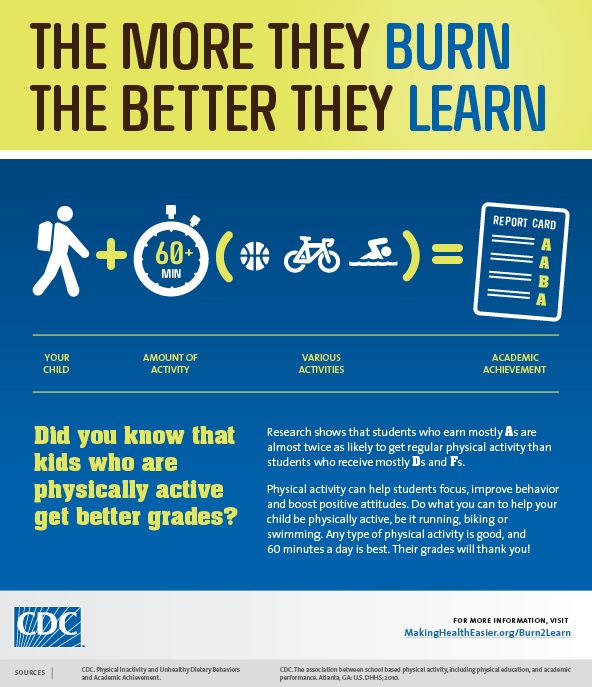Originally posted at LetsMove.gov. The physical activity facts for adolescent and school health were originally published on the Centers for Disease Control and Prevention website.
Physical activity is essential to a healthy lifestyle, and it can be especially important in helping kids do better in school. U.S. Health and Human Services studies show that regular physical activity for kids and teens improves strength and endurance, helps build healthy bones and muscles, and increases self-esteem. Parents, teachers and community leaders can all play a supportive role, and help encourage a healthy lifestyle by promoting physical activity into everyday routines.
For kids and teens (ages 6 to 17 years), here’s the goal:
- Participate in at least 60 minutes of physical activity daily. Whether it’s playing outside at recess, joining intramural clubs, or interscholastic sports, kids need to be active. Show them that physical activity is fun!
Here’s why it’s important:
- Strong bones and muscles: Helps build and maintain healthy bones and muscles.
- Reduces the risk of obesity: Helps reduce the risk of developing obesity and chronic diseases, such as diabetes, cardiovascular disease, and colon cancer.
- Makes kids more confident: Reduces feelings of depression and anxiety and promotes psychological well-being.
- Improves academic performance: May help improve students’ academic performance, including, academic achievement and grades, and concentration and attentiveness in the classroom.
Here are some important resources to learn more:








I have competed in athletics from fifth grade to my junior year of college as a varsity athlete. I truly believe that my physical activities greatly impacted my academic success. I understand that everyone is not a stand out athlete, but that should not stop children from participating in recreational sports or simply just going outside and playing a pickup game of basketball. Majority of my friends growing up were involved in some type of physical activity such as dance, cheerleading, basketball, volleyball etc. It was these same friends that also excelled in the classroom. I understand that this is not a true testimony for everyone, but for me the children who excelled academically were involved in some type of physical activity.
For many families, getting a child involved in athletics at a young age is too expensive. Growing up in the inner city of Indianapolis, IN, organized sports teams were not something the children in my neighborhood or classroom were involved in. We all played outside for hours at a time, but most of our parents could not afford to place us on some type of sports team. It wasn’t until my family moved into a wealthier part of Indiana that I became aware of different types of organized teams. There were so many different opportunities and physical activities to get involved in that I didn’t know where to even start. It saddens me that the children from my old neighborhood and classrooms missed out on these opportunities because I do believe it had an enormous impact on my academic success.
Although many families can’t enjoy the luxury of placing their child on a travel sports team, that shouldn’t stop parents from encouraging their children to go outside and play. I think children are more willing to play outside if their parents go out and join them. I loved when my mom or dad came out and played a game of tag with me. These are the memories I remember most. Most importantly, the impact playing outside has on your child’s health and yours is well worth an hour of your time each day. I truly believe implementing physical activities in children’s lives will increase their self-esteem, better their daily moods, and improve their abilities in the classroom.